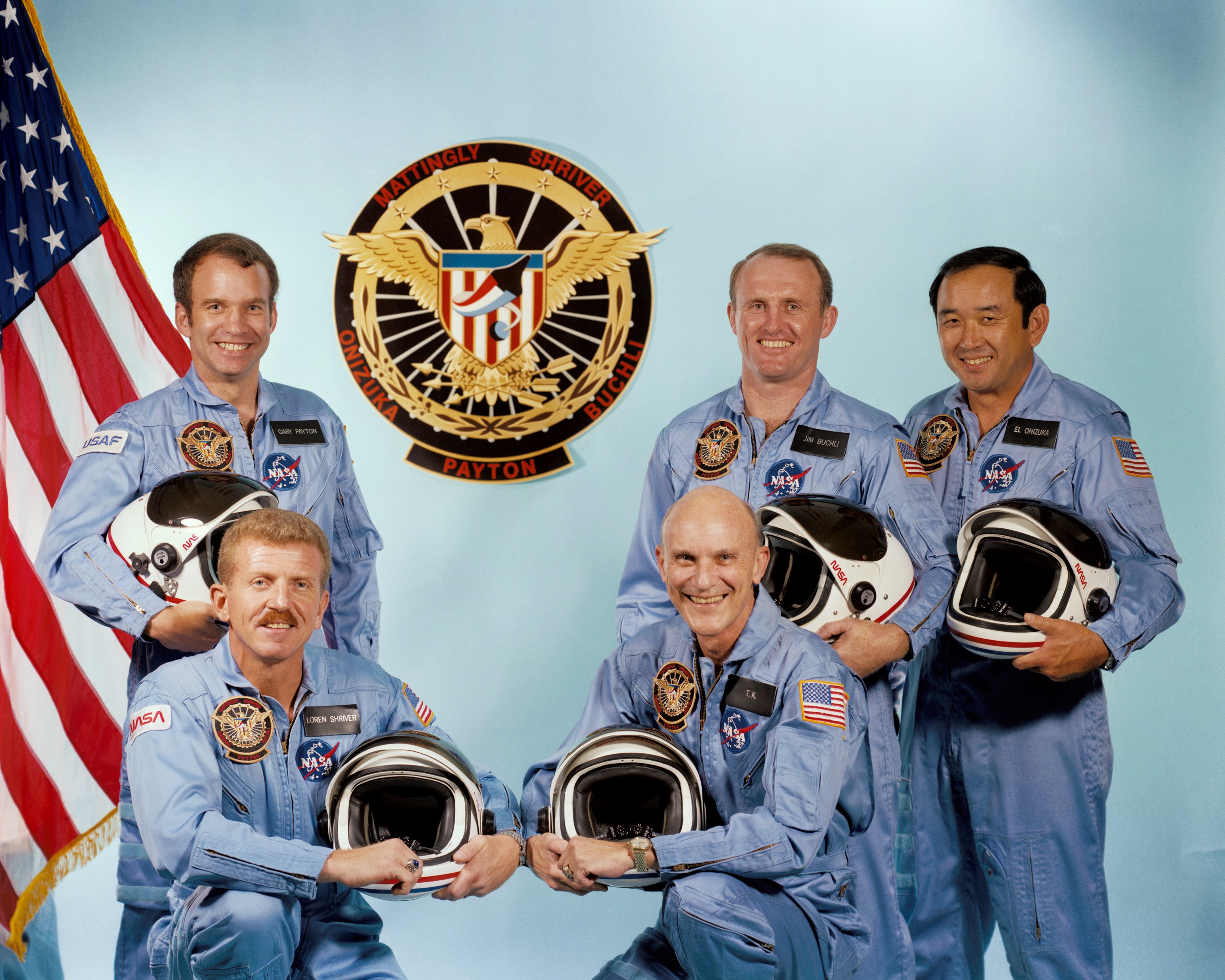
Thirty years ago, this week, the crew of Discovery—Commander Ken Mattingly, Pilot Loren Shriver, Mission Specialists Ellison Onizuka and Jim Buchli, and Payload Specialist Gary Payton—flew the first wholly classified voyage of the shuttle era. As described in yesterday’s AmericaSpace history article, the astronauts’ training had been unusual, in that it was conducted in near-total secrecy, and even the precise launch time did not become apparent to the general public until the countdown clock emerged from its pre-planned hold at T-9 minutes. Until then, spectators at the Kennedy Space Center (KSC) beheld a blank face on the famous countdown clock. Then, at 2:41 p.m. EST on 24 January 1985, the communications blackout abruptly ended with a statement:
“ … T-9 minutes and counting. The launch events are now being controlled by the ground launch sequencer … ”
The remainder of the countdown proceeded normally, and Discovery lifted off at 2:50 p.m. and thundered into the cold Florida sky. Ascent was interesting, because communications between the orbiter and Mission Control were kept strictly under wraps, with only the voice of the commentator reading off a string of standard calls pertaining to the performance of the main engines, the fuel cells, the Auxiliary Power Units (APUs), and the shuttle’s steadily increasing altitude and velocity. No indication was given as to the precise duration of the mission—one source reported that NASA would reveal this information a mere 16 hours before the scheduled landing—and, with the exception that the classified payload would be deployed later that day, very few other details were released about the flight. Many of the accredited members of the press who were in attendance mocked the “secrecy”; one NBC journalist quipped that “a Russian tourist on a Florida beach, a hundred miles away, could have called the Kremlin with the exact launch time!”
Today, three decades later, Mission 51C remains classified, but rumors have emerged over the years that Discovery’s crew possibly deployed a spacecraft codenamed “Magnum”—a signals intelligence satellite, operated by the National Reconnaissance Office (NRO) for the CIA—which was boosted into near-geostationary orbit by its attached Inertial Upper Stage (IUS) booster. Reports have suggested that the TRW-built Magnum weighed somewhere between 4,800-6,000 pounds (2,200-2,700 kg) and was notable for its physical size, featuring 330-feet-wide (100-meter) umbrella-like reflecting dish antennas to collect radio frequency signals from Earth. Aviation Week noted that Discovery entered an orbit of 126 x 322 miles (204 x 519 km), inclined 28.45 degrees to the equator, and executed three burns of her Orbital Maneuvering System (OMS) during the first four circuits of the globe. The payload was then deployed during the seventh orbit.
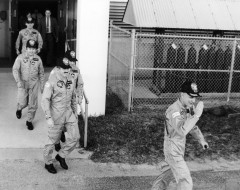
Deployment was the responsibility of the entire crew, although this crew was unusual in that it included a unique military expert: Major Gary Payton of the U.S. Air Force, a member of a new cadre of payload specialists, known as Manned Spaceflight Engineers (MSEs), specifically chosen by the Department of Defense for these classified missions. From its earliest conception the shuttle was dominated by the ambitions of the Air Force, and an assumption had long been made that the Department of Defense would employ the reusable spacecraft to carry many of its classified payloads. A new launch site was being built at Vandenberg Air Force Base, Calif., for near-polar missions, and efforts also encompassed the design and construction of a dedicated Mission Control, known as the Shuttle Operations and Planning Center (SPOC). However, as the 1970s wore on and military budgets withered under Jimmy Carter’s Democratic administration, the Air Force opted to delay the SPOC in favour of making modifications to NASA’s Johnson Space Center (JSC) in Houston, Texas, to support its missions. Parallel plans to permanently assign one orbiter (probably Discovery) to military objectives and hire a dedicated Air Force astronaut corps to fly the missions were abandoned, and it was decided to use personnel already detailed to NASA. “The only opportunity for an Air Force program,” wrote space historian Michael Cassutt, “seemed to be in NASA’s new class of payload specialists.”
It was Air Force Under-Secretary Hans Mark (later to become Deputy Administrator of NASA under Jim Beggs) who introduced the new MSE position in January 1979 and assigned responsibility for its development to Lieutenant-Colonel Robert Christian of Los Angeles Space Division. Early guidelines called for candidates to have between three and 10 years’ of active military service, to rank between a first lieutenant and a major, to be able to pass NASA’s required flight physicals, to hold a degree in engineering or science, and to have at least two years’ experience in programme acquisition, test, and launch support, or flight and missile operations. By August, 14 officers had been selected—a dozen from the Air Force and two from the Navy—although two of them declined the invitation and only one was replaced. Consequently, 13 manned spaceflight engineer candidates arrived at Air Force Space Division in El Segundo, Calif., in February 1980, under Christian’s command.
Their selection was trumpeted by the Air Force as an illustration that the service had a bright future in human spaceflight, although little interest was shown in NASA’s offer to invite the 13 candidates to Houston for two years of training and evaluation. “At that time,” grumbled one senior officer, “any Air Force guy who went to NASA never came back!” The Air Force’s rejection led the civilian space agency to close ranks, refusing further assistance for the manned spaceflight engineers and insisting that it had neither chosen them, nor was it able to control them.
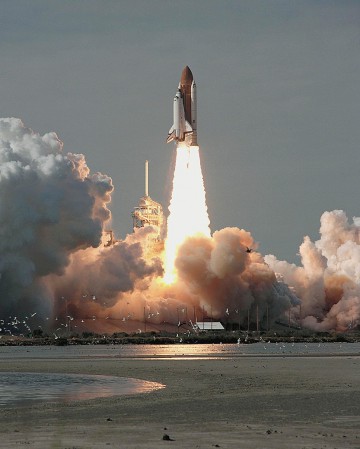
“I was naïve enough to believe that the payload side would be treated by NASA the same way the Air Force launch people treated us,” Gary Payton explained later. “In the world I came from, payload requirements would drive the time of day you launched, the time of year; everything. In 1980, NASA was still worried about getting the shuttle to fly, so we were not paid much attention. It was a rude awakening.” Some space agency officials felt that the newcomers should be considered as “engineers,” not “fliers,” and should not participate in any flight-related training until they were formally assigned to a shuttle crew. Frustrations over the excessive secrecy imposed on the Department of Defense missions often boiled over into disputes. Nevertheless, the MSEs proceeded with their duties, working on the development of military payloads, including the Navstar Global Positioning System (GPS), the Defense Satellite Communications System (DSCS), and others, and the group completed training in December 1981. By the late summer of the following, 14 more candidates had been selected, including two women and one black officer, with a broader range of academic credentials, ranging from bioenvironmental research to computer science and weapons engineers to rescue pilots.
In June 1982, several classified payloads were carried into orbit aboard STS-4 and several MSEs were involved in the preparation and execution of this mission. Even so, their relationships with NASA astronauts were poor. Ken Mattingly, who commanded STS-4, described them as “sour.” At around this time, Gary Payton and Keith Wright were announced as candidates for the STS-10 mission and a handful of others—Jeff Detroye, Eric Sundberg, Brett Watterson, Frank Casserino, and Daryl Joseph, all from the first MSE group—were assigned to support follow-on flights. Their roles would be to operate military experiments and observe the deployments of classified satellites. In the summer of 1983, Payton was assigned as the prime MSE on Ken Mattingly’s STS-10 crew.
Some sources have speculated over the years that the inclusion of MSEs was a method of preventing the NASA crew from gaining too much knowledge of the classified payload. For his part, Loren Shriver did not see Payton’s role in this way; he was very much like any other payload specialist, assigned to the crew to complete his own experiments and tasks. “Gary had a specific purpose,” he said, “but I don’t think it was to make sure that we didn’t learn about what the details of the mission were. As a matter of fact, we all got briefed into the mission and we knew exactly what was going on.” Many of their efforts were effectively hamstrung by the failure of the IUS in April 1983, and, although Cassutt has noted that several payloads were “dual-configured” and could be launched by either the shuttle or an expendable Titan booster, it would seem that Magnum was designed specifically for deployment from the orbiter’s payload bay. As a result, it could not be cancelled, only moved to the next available shuttle opportunity. “In any case,” Cassutt wrote, “because of Magnum’s importance, the DoD exercised its launch-on-demand option, pre-empting the next shuttle-IUS spot on the manifest.” According to the January 1984 manifest, Mission 51C was to have been an IUS flight to deploy the second Tracking and Data Relay Satellite (TDRS), but by May its slot had been taken by Magnum. The TDRS was moved a couple of months downstream and reassigned to 51E.
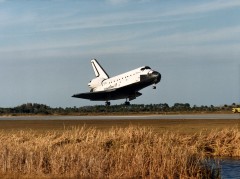
If Gary Payton’s role was as an observer of Magnum and the IUS, then responsibility for the actual deployment of the payload fell to Ellison Onizuka—the first Asian-American astronaut of Japanese-American parentage—and Jim Buchli. Certainly, the deployment itself went perfectly, for Onizuka would soon be assigned to another IUS deployment flight, Mission 51L, with a TDRS. Onizuka said in a pre-flight interview for 51L that he was “very familiar” and “very comfortable” with the performance of the IUS, strongly suggesting that the earlier problems with the booster had been overcome by the spring of 1985. (Certainly, changes had been implemented in the nozzle design and four successful altitude-chamber firings were performed.)
To this day, 51C remains the shortest operational flight of the shuttle; when Discovery touched down at KSC at 4:23 p.m. EST on 27 January, she chalked up a mission of just over three days. It was the final flight for Ken Mattingly, who had already announced his retirement from NASA in July 1984 to return to active duty in the Navy as head of space programmes for the Naval Electronic Systems Command in Virginia. In fact, he took up his new post only two weeks after 51C landed. Years later, Mattingly admitted that only one other mission might have kept him with the civilian space agency. “The only mission that I really thought I could get interested in was the first Vandenberg mission,” he told the NASA oral historian, “and [Bob Crippen] was already doing that, so I decided it was probably best to change assignments.”
It would appear that the Navy originally wanted Mattingly to head up its new Naval Space Command at Dahlgren, Va., but the 51C delays meant that he either had to drop the shuttle flight or lose the assignment. “I wanted to stay and finish the mission,” he said, “because we spent so much time on it and it was a particularly good one for me, because those guys [on the crew] were so good.” In Mattingly’s mind, 51C was really “Loren’s mission,” with Shriver cutting his teeth as a pilot before moving on to command his own shuttle flight. It is interesting that all three NASA members of the crew went on from the closeted world of Department of Defense operations to participate in three of the most dramatic and visible missions of the decade: Buchli would be aboard a joint Spacelab mission with West Germany in October 1985, Shriver would later command the flight to deploy the Hubble Space Telescope … and Onizuka, tragically, would secure his own place in history as a member of Challenger’s final crew.
This is part of a series of history articles, which will appear each weekend, barring any major news stories. Next week’s article will focus on the 20th anniversary of STS-63, the first shuttle mission to approach the Mir space station and a pathfinder for the subsequent shuttle-Mir era of docking flights.
Want to keep up-to-date with all things space? Be sure to “Like” AmericaSpace on Facebook and follow us on Twitter: @AmericaSpace




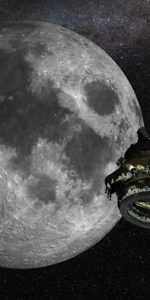
When the 51C crew returned to Ellington, Gary Payton was overheard asking why the mission had been cut short. Whatever the answer, it was not provided there where I or other reporters could overhear. Payton seemed somewhat upset, not sure if it was frustrated or something else.
The real and tragic legacy of 51C is that it sustained a near burn-through of exhaust gas from an SRB during launch. However, that information was kept classified and from most of the engineers who worked on the SRBs, only becoming public knowledge in the wake of the loss of 51L. It was a burn-through, of course which ended the lives of 7 astronauts. That was one of several stories I broke in the weeks after the loss.
What a great story. Looking forward to more like this. Here in Australia we always knew the times of the liftoffs of the military flights as we had to co-ordinate our work. Our oath of secrecy was enough to hold our tongues.
What a terrific and important 51C was 30 years ago. I had responsibility for the flight operations of the DoD spacecraft from NASA MCC and hence spent three wonderful years working with Ellison on preparing for launch day. Great crew, great stories and great memories from our very first control-mode DoD flight in the control center. Interesting was that our first classified end-to-end test between the MCC and the Orbiter/spacecraft was meant to be a mere 8 hours….but ran 64 hours as we leaned how to get all the encrypted comm gear to talk with each other. So many fun stories from this mission!
“A stinger for my friends”